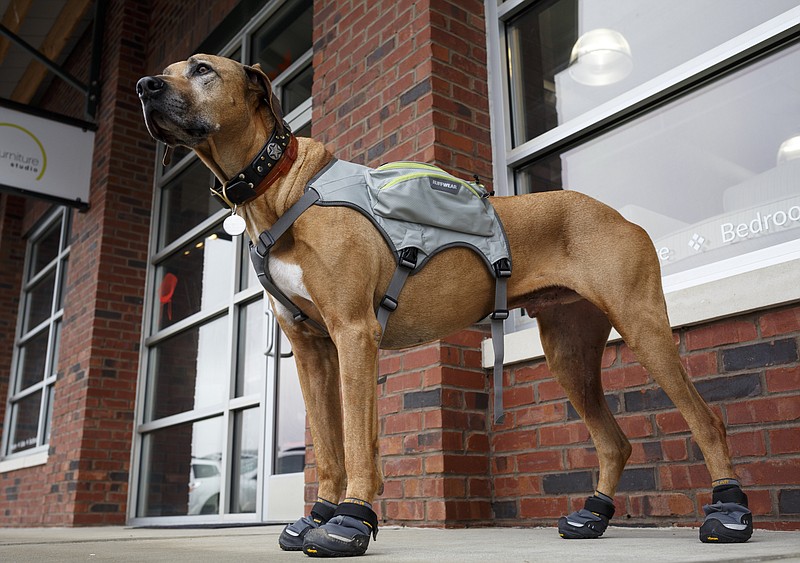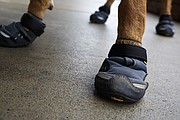Photo Gallery
Roly-poly pets: Dogs, cats, bunnies — even parrots and snakes — can get fat if they're not fed properly
Weight loss tips
› Don’t just keep refilling the pet’s bowl or birdcage feeder. They usually eat as often as they see food. Feed them at specific times during the day.› Look at the ingredients on the bagged or canned pet food. Don’t buy dog or cat food that contains sugar, grains, corn, soy or additives. They’re not easy for your pet to digest.› Give your cat or dog cooked chicken, fish or beef for breakfast/dinner and chopped-up pear or cubed apples for special snacks. Stay away from packaged biscuits.› Green beans are a hit with most dogs as a low-calorie treat that is high in antioxidants.› A rabbit’s digestive system is designed for hay and veggies. When a pet owner deviates from that diet, the bunny gets belly fat and problems. Remember, Peter Cottontail didn’t invade the farm looking for steak. In addition to veggies, bunnies need good quality hay for roughage. An occasional slice of fruit can be a treat.› Snakes get fat when their owners feed them too many mice. Stop that. Don’t be that guy.Sources: Claws and Paws’ Dr. Shannon Dawkins, Tri-County Animal Clinic’s Trey Moyer, Nooga Paws owner Bob Poore
The humans who adopted Wilson, a black lab mix, brought him from the animal shelter to their Hixson home, where he was so smart he learned to do tricks the first day. Their love made his sweet, friendly personality blossom.
But his torso also blossomed with chunky love handles until he was shaped like a giant sausage. He easily became exhausted trying to waddle up the porch stairs, and he clearly felt uncomfortable climbing onto the corner of the couch reserved for him.
For help, his owners turned to Dr. Shannon Dawkins, a veterinarian who calls her medical practice Claws and Paws. She drives a truck outfitted with a mobile surgical unit complete with lasers, a scale, an anesthesia machine and a fridge to store blood and medicines. She drives to pet owners' homes then weighs, examines and even operates on furry, feathered and scaly patients.
The same signs that can be seen on Wilson are part of an epidemic that has hit Chattanooga and pretty much everywhere else: pudgy pooches, beach ball-shaped cats, parrots that look like watermelons, blubbery bunnies, even chubby snakes.
"Obesity is becoming as big a problem for pet cats, dogs, parrots and rabbits as it is for their humans," says Dawkins. "Pets - including birds and bunnies - face most of the same obesity-related dangers that plague humans: hypertension, heart problems, high blood pressure, diabetes. Even snakes face obesity-related illnesses."
A 2014 Association for Pet Obesity Prevention study declared that at least half of pet dogs and cats in America are obese. Cats have a bigger battle with the bulge than dogs; 57 percent of pet felines are too fat compared to 52 percent of dogs. The study was based on the wellness exams of 1,421 dogs and cats whose vets reported obesity data to the association.
"The good news is, the problems can be corrected by nutrition and exercise and, sometimes when the pet loses weight, his owner does, too, and they both become healthier," Dawkins says.
Wilson's owner, Mary Kay consultant Lyndsey Johnson, lost 100 pounds after she and Wilson began a nutritional and exercise makeover last fall. And Wilson is now trim and so fit he recently leaped from the lawn over four steps onto the back deck to greet visitors. He was deliriously happy, running in circles to greet a visitor.
"After I had gastric bypass surgery last year, I wanted to get in shape and be fit and not regain weight, and Dr. Dawkins gave me tips for how to help Wilson do the same," Johnson says. "Wilson and I would go for a walk every evening and my son Trevor played fetch with him outside to keep Wilson moving."
Johnson is a vegetarian but Dawkins told her dogs need meat proteins to be in top form. Neither cats nor dogs digest grains well because their digestive tract is so much shorter than a human's. Unfortunately, a lot of pet food is chock full of grain fillers.
"Instead of dog food, I fed him whole food like cooked chicken and chopped up bananas. One of his favorite treats was little carrots," Johnson says.
Dawkins recommends that all pet owners take a close look at what they're feeding their portly pet, especially the ingredients list on whatever store-bought food they're using.
"If you look at a bag of most dried dog foods, one of the main ingredients is usually sugar," she says. "It's as frustrating as seeing all those sugar-packed cereals aimed at children. Kibble is really just the Trix cereal of the dog food world."
Fat Cat
Dawkins and her husband bicycle with a group of cycling enthusiasts, one of whom told her his sad tale of his cat who is as fat as a furry beach ball. To try to control the cat's voracious appetite, he installed a timed feeder at home so she could only eat at scheduled intervals. But his cat learned to unfasten the feeder door with her paw so food cascades all over her any time she wants. He tries to give her exercises by shooting a laser pointer around her to chase but she makes it clear she thinks the game is silly and ignores him.
Unlike dogs, cats don't beg their humans for a chummy walk. For dogs who are so fat walking hurts their joints, Dawkins has an underwater treadmill at a nearby swimming pool. But cats don't like getting wet.
"Cats are a challenge when it comes to losing weight," Dawkins admits. "Sometimes they rebel if you try to get them to eat at set times rather than any time they want."
Dogs and cats feel the same withdrawal pangs as humans when do when they give up their sugary delights.
"Make any diet change gradually," Dawkins advises. "If your pet is overweight, work towards slow, gradual weight loss."
Part of getting a pet healthy is making sure they don't chow down just for fun.
"Cats are hunters by nature, so wrap their food up in paper and put it in a high place so they have to climb up to get it," Dawkins recommends. "They will burn up calories searching for their food.
"The same tactic works for fat parrots. Hide the food and let them search. Parrots have the intelligence of a 2-year-old human so they are good at that game."
Trey Moyer, a veterinarian assistant at the Tri-County Animal Clinic in Murphy, N.C., advises cat owners to build little stairs out of books or blocks and put the food at the top.
His clinic offers a host of holistic medical treatments for obese pets, including electroceutical therapies, which use electric stimulation to treat various problems. Inflamed joints and tissues make it harder for humans and pets to exercise, Moyer says, but the treatments have alleviated arthritis for some patients.
"We sometimes recommend our clients buy Kangen water, which is very alkaline and also reduces inflammation," Moyer says. "Kangen water is easier for animals' cells to absorb so it keeps them better hydrated than tap water would."
Moyer reminds animal lovers that playing with your pet is as good a way of showing love as handing them a treat and they also get the benefit of exercise. If you must give treats, he says find a low-calorie, nutritious choice, including some vegetables.
"Dogs love green beans - frozen, canned or cooked - they love them as much as humans love candy," Moyer says.
No bud for buddy
When Nooga Paws co-owner Bob Poore takes his Rhodesian Ridgeback hiking in the mountains, the dog wears a little canine backpack that holds canine water bottles. The dog, named Bode (pronounced BOW-dee), also wears four little hiking boots to protect each of his paws.
Poore was an environmental engineer and his wife, Courtney, was an MBA when their beloved dog was diagnosed with fatty tumors, which their vet told them it is a commonplace affliction for American pets. They began researching canine and feline nutrition and, in 2012, decided to open a store full of healthy food options and exercise inducements for pets, a sort of Earth Share/Dick's Sporting Goods for animals. Customers come to Nooga Paws for nutritional advice as well as shopping.
Store shelves are lined with bags and cans of food that are sugar- and gluten-free and packed with protein and vitamins. Choices range from fish and coconut to turkey and parsnips to a pheasant/fish and rabbit combo.
"The best food for a pet trying to shed some weight is ground venison, buffalo, beef or other animals with the diced and chopped organs - brains, livers, hearts - bits of horn and bone all mixed together and molded into a patty," Poore says. "Remember, dogs are related to wolves and cats to tigers. Out in the wild, wolves and tigers feast on an entire animal and suck on the bones, hooves and claws because there is some nutritional value to that organic matter."
Inside Nooga Paws is a display of animal parts in glass jars that look like they were spirited out of a witch's laboratory. There are sheep hooves, buffalo horns, bull tracheae, lambs' ears, ducks' feet, pigs' ears and pigs' snouts that look like big pink burgers with two huge nostrils. Each body part is roasted over a low temp then vacuum-packed.
"They're like nutritional supplements, extra nutrients in addition to a healthy diet," says Nooga sales associate (they call themselves "pack members") Patrick Honan, who owns three dogs.
Contact Lynda Edwards at ledwards@timesfreepress.com or 423-757-6391.

